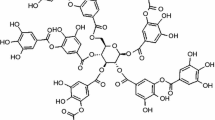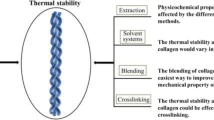Abstract
The thermal stability of sheepskin collagen cross-linked with chrome sulfate and mimosa (MI)–oxazolidine (OZ), respectively, had been researched in this experiment. All samples’ shrinkage temperatures (T s) are determined by a special T s-testing-apparatus and denaturation temperatures (T d) are determined by the differential scanning calorimetry. The relations between the modified collagens containing moisture and their hydrothermal stability, T s or T d, were studied. The results show that the cross linking agents can enhance the thermal stability of modified collagen whose T s are 109.8 and 110.6 °C for collagen treated with chrome and MI–OZ, respectively. When the samples contain 25–71.9% moisture for chrome leather and 20–71.1% for leather treated with MI–OZ, the hydrothermal stability will decrease with the increase of moisture. It was found that the difference between T s and T d of collagen modified by chrome is more obvious than that of collagen modified with MI–OZ. And when the moisture of chrome leather exceeds 55%, T d cannot express thermal stability of modified collagen as a substitute for T s, and the moisture is 40% for leather tanned with MI–OZ.




Similar content being viewed by others
References
Brown EM, Farrell HM, Wildermuth RJ. Influence of neutral salts on the hydrothermal stability of acid-soluble collagen. J Protein Chem. 2000;19(2):85.
Vesantini S, Redaelli A, Montivecchi FM. Estimation of the binding force of the collagen molecule-decorin core protein complex in collagen fibril. J Biomech. 2005;38:433–43.
Usha R, Ramasami T. Role of solvents in stability of collagen. J Therm Anal Calorim. 2008;93(2):541–5.
Hu X, Kaplan D, Cebe P. Thermal analysis of protein-metallic ion systems. J Therm Anal Calorim. 2009;96:827.
Usha R, Ramasami T. Effect of hydrogen bond breaking reagent (urea) on the dimensional stability of collagen. J Appl Polym Sci. 2002;84:975–82.
Catanzano F, Graziano G. On the cooperativity of the thermal denaturation of mini-protein. J Therm Anal Calorim. 2008;91(1):57–60.
Fathima NN, Madhan B, Rao JR, Nair BU. Effect of zirconium(IV) complexes on the thermal and enzymatic stability of type I collagen. J Inorg Biochem. 2003;95:47–54.
Fathima NN, Chandrabose M, Rao JR, Nair BU. Stabilization of type I collagen against collagenases (type I) and thermal degradation using iron complex. J Inorg Biochem. 2006;100:1774–80.
Bowes JH, Cater CW. The interaction of aldehydes with collagen. Biochim Biophys Acta. 1968;168:341–9.
Shan ZH, Wang GW. Combination tannage of tannic acid and rare earth. J Soc Leather Technol Chem. 2004;88(2):72–5.
Bienkiewicz KJ. Leather–water: a system. J Am Leather Chem Assoc. 1990;85:305–25.
Larsen R. Experiments and observations in the study of environmental impact on historical vegetable tanned leathers. Thermochim Acta. 2000;365:85–99.
Chahine C. Change in hydrothermal stability of leather and parchments with deterioration: a DSC study. Thermochim Acta. 2000;365:101–10.
Cohen NS, Odlyha M, Foster G. Measurement of shrinkage behaviour in leather and parchment by dynamic mechanical analysis. Thermochim Acta. 2000;365:111–7.
Wess TJ, Orgel JP. Changes of collagen structure by drying dehydrothermal treated and relation to long term deterioration. Thermochim Acta. 2000;365:119–28.
Fessas D, Schiraldi A, Tenni R, Zuccarello LV, Bairate A, Facchini A. Calorimetric, biochemical and morphological investigations to validate a restoration method of fire injured ancient parchment. Thermochim Acta. 2000;348:129–37.
Usha R, Ramasami T. Alcohols on the stability of rat-tail tendon (RTT) collagen fiber. J Polym Sci Polym Phys. 1999;37(13):1397–405.
Shan ZH, Xin ZY. Studied on nonmetal tanning-organic combined tannage. Leather Sci Eng. 2002;12(5):19.
Budrugeac P, Miu L. The suitability of DSC method for damage assessment and certification of historical leathers and parchments. J Cult Herit. 2008;9:146–53.
Wang YJ, Chen H, Shan ZH. The synergistic effect of different rigid matrix. Leather Sci Eng. 2007;17(2):17.
Acknowledgements
For financial support, the authors would like to thank the Research Fund for the Doctoral program of Higher Education (No. 20050610046) and National Science Foundation of China (No. 50573051). We would also like to thank those authors who provided preprints prior to publication.
Author information
Authors and Affiliations
Corresponding author
Rights and permissions
About this article
Cite this article
Wang, Yj., Guo, J., Chen, H. et al. Influence of containing moisture on hydrothermal stability of modified collagen thermal characteristics analysis by DSC. J Therm Anal Calorim 99, 295–300 (2010). https://doi.org/10.1007/s10973-009-0561-y
Received:
Accepted:
Published:
Issue Date:
DOI: https://doi.org/10.1007/s10973-009-0561-y




